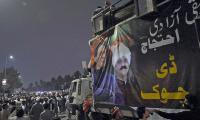Nawaz Sharif’s physical absence and the detention of Shahbaz Sharif has paved the way for Maryam Nawaz to spearhead the Pakistan Muslim League Nawaz (PML-N).
Maryam’s rise within the PML-N ranks underscores the ascendancy of hawks over doves since the posture of accommodation has only squeezed the political space for the party in the last two years. Furthermore, Nawaz’s September 20 speech is the party’s official political narrative from hereon.
Maryam is leading the PML-N at a make-or-break juncture of its political evolution. Indubitably, she is a charismatic leader, an eloquent speaker and a genuine crowd-puller, but it remains to be seen if she can keep the party intact in such trying circumstances. She represents the younger generation of PML-N leaders and vote bank both.
Nawaz’s defiant speech at the joint opposition’s Multi Party Conference has closed the doors for political reconciliation. If the PML-N’s reaction to Shahbaz’s arrest is anything to go by, it becomes evident that the party will not relent from its defiant posture and will continue to raise the political temperature with each passing day. This will be the first time in Pakistan’s troubled constitutional history that a mainstream political party from Punjab enters the realm of political resistance.
Notwithstanding South Asia’s patriarchal culture, the region has produced some strong women politicians – India’s Indira Gandhi, Bangladesh’s incumbent chief executive Sheikh Hasina Wajed and Begum Khaleda Zia, as well as Pakistan’s Benazir Bhutto.
Though Maryam has never contested elections, she has held various positions within the PML-N, including heading its social media wing. At present, she is the vice president of the party. Maryam rose to prominence following the PML-N’s emphatic victory in the 2013 general election. Her name also resonated in the 2016 Dawn leaks. She has been prisoned intermittently following her disqualification by the Supreme Court in the Panama Leaks case. Since then, she has been a symbol of defiance and anti-status quo politics within the PML-N.
Maryam has no prior experience of leading a resistance movement against a sitting government. Giving hard-hitting speeches and pulling large crowds in political rallies is one thing, but street agitation and protests involve a different level of ideological commitment and resilience from party workers and supporters. It is said that resistance is not in the PML-N’s political DNA. The Pakistan Democratic Movement’s two-phased agenda of protests and rallies culminating in a long-march towards Islamabad will test this assumption as well as the PML-N’s political resolve and nerves.
So far, the PML-N has shown exemplary party discipline and organizational coherence in the face of detentions, disqualifications and the ruling PTI’s attempts to create forward blocs in the party. The rapidly evolving political situation could place several PML-N leaders between a rock and a hard place. The PTI government will use the carrot and stick approach to chip away at vulnerable PML-N leaders.
The pro-reconciliation bloc within the PML-N is at a crossroads; it will have to decide its political future with the party in the coming weeks. Twice, in the near past, some PML-N leaders, first during the no-confidence move against Senate Chairman Sadiq Sanjrani and more recently during the FATF-related anti-money laundering bills in the parliament joint session, either voted against the party guidelines or absented themselves. Aware of this dichotomy, Maryam acknowledged in her September 28 presser that “it will not be possible for all to carry the burden of the Nawaz’s (defiant) political narrative.”
Ahead of the upcoming anti-government protests and rallies, this possibly hints at a purge and restructuring within the PML-N. Maryam will strengthen her position in the party by bringing in her team of loyalists and hawks. The time-window is pretty narrow, and the stakes are quite high for the PML-N. The Senate election is due in March next year. If the government is not dislodged by that time, it will gain majority in both houses of parliament. While in Pakistan’s political context it is foolhardy to write off any political actor, the PML-N would be reduced to a former shadow itself if it fails to remove the PTI government.
The public anxiety regarding growing unemployment, rising inflation and poverty favours the PML-N to attract a positive public response to its anti-government rallies. However, it remains to be seen whether the PML-N can generate enough political momentum and subsequently sustain it in the run-up to the January 2021 long march in unison with other opposition parties.
Pakistan’s democratic transition, despite the continuation of civilian rule, has more or less remained procedural, failing to evolve into a substantive democracy. If things spin out of control, during this anti-government movement, it can potentially roll back Pakistan’s fledgling democratic project. The collapse of elite consensus in Pakistan necessitates a grand national dialogue that takes the country out of the present political gridlock and halts further political polarization and divisions. Time will tell if Maraym succeeds in steering Pakistan’s fragile democracy out of these troubled waters and puts it on a substantive path.
The writer is a research fellow at the S Rajaratnam School of International Studies, Singapore.
Email: isabasit@ntu.edu.sg
Data, today, defines how we make decisions with tools allowing us to analyse experience more precisely
But if history has shown us anything, it is that rivals can eventually unite when stakes are high enough
Imagine a classroom where students are encouraged to question, and think deeply
Pakistan’s wheat farmers face unusually large pitfalls highlighting root cause of downward slide in agriculture
In agriculture, Pakistan moved up from 48th rank in year 2000 to an impressive ranking of 15th by year 2023
Born in Allahabad in 1943, Saeeda Gazdar migrated to Pakistan after Partition







